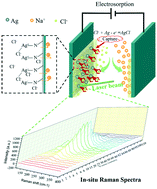A newly synthesized highly stable Ag/N-carbon electrode for enhanced desalination by capacitive deionization†
Abstract
Capacitive deionization (CDI) by Ag@C electrodes is a promising desalination technology for chlorine removal because there is no waste flow and no additional chemicals used during the removal and regeneration/cleaning processes. However, its efficacy and capacity are significantly limited by the low stability of Ag/C composites during the electrochemical process. In this study, we synthesized a new highly stable structure of Ag@C composites (named as Ag/N-CNP) through reductive adsorption of Ag+ by a polyaromatic amine followed by carbonization. We used in situ Raman spectroscopy, for the first time, to monitor in real-time the Cl− electrosorption/desorption process of Ag/N-CNP electrodes, which revealed that the stability of Ag@C electrodes was mainly controlled by the dissolution of Ag. The newly synthesized Ag–Nx structure stabilized Ag nanoparticles and uniformly distributed Ag species on the carbon matrix, which resulted in a high affinity for Cl− and significantly improved cyclic dechlorination performance. Results showed that the electrosorption capacity of the newly synthesized Ag/N-CNP electrodes could reach 75.3 mg g−1, substantially higher than that of traditional carbon electrodes. Moreover, such a capacity had almost no loss (only 1.4% loss) after 50 continuous treatment cycles and could still retain 76% after 100 cycles, demonstrating a highly reliable and cost-effective desalination performance significantly superior to that of previously reported Ag@C electrodes.



 Please wait while we load your content...
Please wait while we load your content...